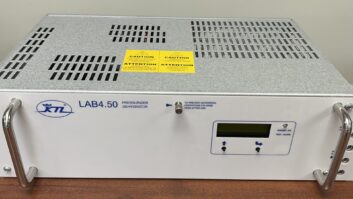The Electro-Voice RE20 is a must-know microphone for every audio professional. After all, most broadcasters own between two and 20. They are regularly placed in front of kick drums, bass and guitar cabs, not to mention the majority of radio/TV announcers.
As a matter of fact, the RE20 could arguably be one of the most popular microphones ever, neck-and-neck with the ubiquitous Shure SM57.

Divakar Shukla of WEND evaluates the new RE320 (left) alongside the original RE20. Photo by Rob Tavaglione
Thus, we will review the RE20’s modern update, the E-V RE320, in a purely comparative manner. For an even broader perspective, let’s also throw in real world comparisons with its sibling microphone, the E-V RE27.
FEATURES
Aesthetically, the RE320 looks very much like an RE20 — featuring that striking, classic vented chassis — with an updated look due to its black gloss finish. As in the E-V RE27, neodymium magnets are present, though high-pass filters — present in the RE20 and RE27 — are not. Another significant difference of the RE320 is its selectable EQ filter voiced for kick drum miking, which offers a low-mid frequency scoop.
IN USE
I first tried the RE320 in a live environment, inside a number of kick drums at a rock club, with filter engaged. Its performance in a word? Punch.
The RE320 translated a lean bottom, plenty of high-mid bass drum shell tone and a well defined “thwack.” The venue’s FOH engineer said he liked it, as it offered “more highs than a Beta 52.” Onstage, the monitors loved it; my biamped monitor rig there is huge, and the RE320’s absence of flab way down low made for the tightest, punchiest onstage kick that I can recall.
In the studio, I found the RE320 to have a sonic signature best suited for rock recording, where higher-end note definition is arguably as crucial as thump and the fundamental. In order to create audio clips for my evaluation, I placed the RE320 inside a 22- × 18-inch Pork Pie kick drum (with damping rings on heads, but no pillows or blankets inside), but obviously no other mic could fit through the resonant head’s small hole. I did sneak in a Shure Beta 91 (also a favorite for rock kick), placing it in the bottom center of the drum, for less than coincidence, but very usable, placement. In audio clips 1A and 1B, the additional bottom and sculpted mids from the RE320 is notable, while the Beta 91 offers pronounced top.
Electro-Voice RE320 – Clip 1A by NB Pro Audio
Electro-Voice RE320 – Clip 1B by NB Pro Audio
On loud electric guitar, the RE320 does a fine job; it offers more bottom than a SM57, less high-mids and more muscle through the low mids. High SPL is no problem for the RE320 and, to my ears, it seems more faithful than colored in direct comparison to the SM57.
Where one might normally use a Sennheiser MD 421 on guitar, the RE320 will excel with more flatness and more excitement. Understandably, the kick drum filter was all wrong on this app, as it removed precious tone.
For a broadcasting applications test, I pulled in the big guns. With the help of on-air personality Divakar Shukla and station engineer Dave Mitchell, we ran the RE320 through a gamut of broadcast tests at WEND(FM) in Charlotte, North Carolina. To evaluate, the RE320 and an RE20 were placed about 75 millimeters from each other and 75 millimeters from Divakar: in an equilateral triangle, directly on-axis, with no pop filters employed.
Technically “improper” (as most announcers angle themselves across the mic head, preventing plosives and excessive mouth noise), this placement was required for accuracy in evaluation; some popping Ps may also be informative about the mics’ plosive performances.
We found the RE320 to have a little more bottom than a RE20, with some scooping at 300 to 800 Hz and nearly the same top end (RE320 and RE20, audio clips 2A and 2B, respectively).
Electro-Voice RE320 – Clip 2A by NB Pro Audio
Electro-Voice RE20 – Clip 2B by NB Pro Audio
Divakar and Dave loved the RE320 and became further enthused when they heard the RE320 with the kick filter engaged (audio clip 3A) in direct comparison to the RE20 (audio clip 3B). Both commented how the RE320 with filter sounded more finished, “as if we had our usual processing turned on,” they said. [The audio clips are with no compression, no processing and no EQ — editor.]
Electro-Voice RE320 Kick – Clip 3A by NB Pro Audio
Electro-Voice RE20 – Clip 3B by NB Pro Audio
Compared to the RE27 (with a hotter output than the RE20 or RE320), the RE20 has less top end and flatter mids; the RE320 sounded a lot like a RE27, at least with its kick filter engaged. Nonetheless, Divakar and Dave still ultimately preferred the RE320 with kick filter over the RE27, citing its “fullness and warmth,” further revealed in audio clips 4A (RE320) and 4B (RE27) as well as audio clips 5A (RE320 with filter) and 5B (RE27). Divakar even said of the RE320, “That’s the way I’m supposed to sound.”
Electro-Voice RE320 – Clip 4A by NB Pro Audio
Electro-Voice RE27 – Clip 4B by NB Pro Audio
Electro-Voice RE320 – Clip 5A by NB Pro Audio
Electro-Voice RE27 – Clip 5B by NB Pro Audio
SUMMARY
Assuming you like the RE20, you cannot go wrong with the RE320. Its additional bottom end seems useful on both kick and VOs; its top end is just as smooth and broadcast-worthy as the RE20; its Variable D proximity effect control is tuned just right; and the RE320 can handle all the abuse of rock ’n’ roll.
Throw in its eminently useful mid-scoop filter (that is equally at home on kick and voice) and it seems the RE320 is a black beauty of a RE20, with lots more versatility and nary a negative.
Rob Tavaglione owns and operates Catalyst Recording in Charlotte, North Carolina.
For information, contact EVI Audio in Germany at telephone: +49-9421-706-0, or visit www.electrovoice.com.







